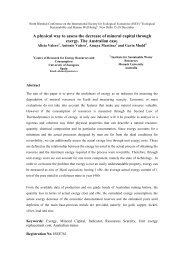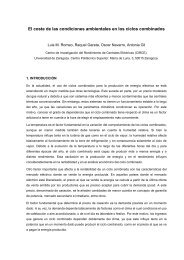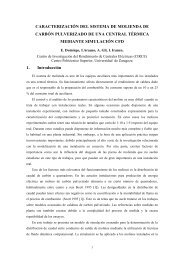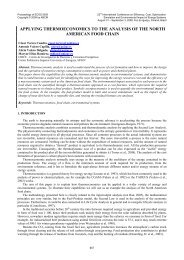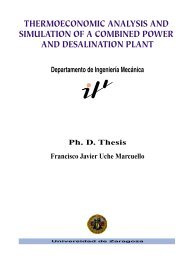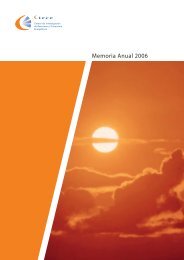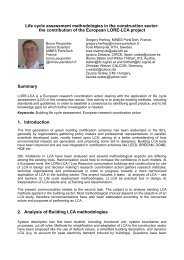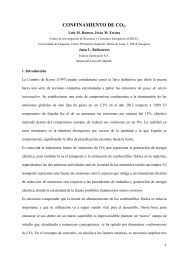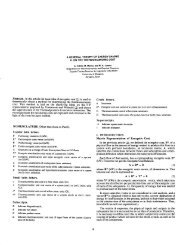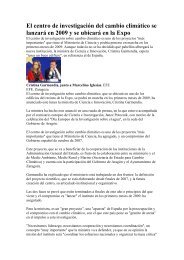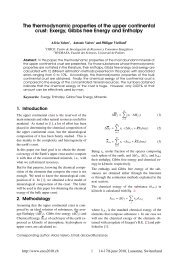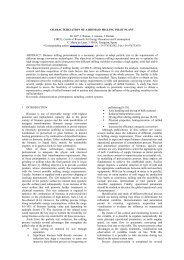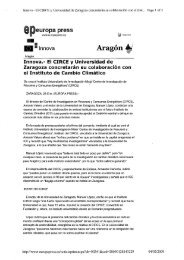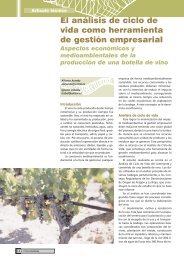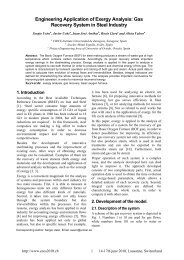towards an international legal reference environment
towards an international legal reference environment
towards an international legal reference environment
You also want an ePaper? Increase the reach of your titles
YUMPU automatically turns print PDFs into web optimized ePapers that Google loves.
<strong>towards</strong> it, since some processes are kinetically, biologically<br />
<strong>an</strong>d/or geologically blocked.<br />
Diederichsen updated <strong>an</strong>d extended Ahrendt’s<br />
model with new geochemical data <strong>an</strong>d obtained<br />
among others, a R. E. including 75 elements. Furthermore,<br />
he allowed the composition of this <strong>environment</strong><br />
to ch<strong>an</strong>ge with two variable parameters:<br />
thickness of the Earth’s crust <strong>an</strong>d oce<strong>an</strong>’s depth. The<br />
final chosen <strong>environment</strong> should comply with the<br />
“Earth similarity criterion”. The similarity with the<br />
Earth was measured with the equilibrium pressure,<br />
the oxygen <strong>an</strong>d nitrogen content in the gas-phase<br />
<strong>an</strong>d the equilibrium salt content in the oce<strong>an</strong>s.<br />
Even though Diederichsen [9] added more elements<br />
th<strong>an</strong> Ahrendts [8] <strong>an</strong>d included a new variable parameter,<br />
the composition of his new Reference Environment<br />
is still too different from the real Earth. According<br />
to the “Earth similarity criterion”, the R.E.<br />
that best fits with the Earth’s <strong>environment</strong> takes a<br />
crust thickness of only 0,1 m <strong>an</strong>d <strong>an</strong> oce<strong>an</strong>’s depth<br />
of 100 m. Greater values would move further away<br />
the R.E. from the real Earth, <strong>an</strong>d would have among<br />
other features, reduced pressures <strong>an</strong>d oxygen contents.<br />
As it happened with Ahrendt’s model before,<br />
Diederichsen obtained high exergy values for oxygen.<br />
This happens because nearly all the oxygen of<br />
the air is consumed basically by the formation of nitrates<br />
<strong>an</strong>d only in the limit, for a crust thickness of<br />
0 m, the me<strong>an</strong> Earth pressure matches with that of<br />
the model. It seems therefore that achieving a R.E.<br />
in chemical equilibrium is in disagreement with the<br />
“Earth similarity criterion” <strong>an</strong>d is not appropriate<br />
for the evaluation of natural capital on Earth. This<br />
idea fully fits with Lovelock’s Gaia hypothesis [10]:<br />
the Earth is a life being <strong>an</strong>d fights against thermodynamic<br />
stable equilibrium.<br />
Kameyama et al. [11] proposed a <strong>reference</strong> <strong>environment</strong><br />
with the criterion of chemical stability. The<br />
<strong>reference</strong>s are the most stable compounds among<br />
those with thermo-chemical data <strong>an</strong>d c<strong>an</strong> be integrated<br />
in the solid, liquid <strong>an</strong>d gaseous <strong>environment</strong>s.<br />
As Szargut stated in [12], some of the<br />
most stable compounds selected by Kameyama et<br />
al. like nitrates, compounds between rare elements<br />
(e.g. PtBr2) or compounds with Fr as the <strong>reference</strong><br />
species for the elements F, Cl, Br, I should not be<br />
recommended, because the probability of their formation<br />
in the <strong>environment</strong> is very small. Therefore,<br />
Kameyama et al. R.E. is not very suitable either to<br />
evaluate the scarcity of the natural capital.<br />
According to R<strong>an</strong>z [13], lots of minerals are compounds<br />
with the most common components of the<br />
upper continental crust, but are not very stable<br />
<strong>an</strong>d do not represent the products of <strong>an</strong> interaction<br />
between the components of the natural <strong>environment</strong><br />
<strong>an</strong>d the waste products of industrial processes.<br />
Hence, R<strong>an</strong>z [13] proposes a new R.E. very close to<br />
the real <strong>environment</strong> based on abund<strong>an</strong>ce <strong>an</strong>d following<br />
Szargut’s criterion. The solid phase of this<br />
new R.E. reproduces accurately the Earth’s upper<br />
continental crust, since the solid <strong>reference</strong> species<br />
that make up this <strong>environment</strong> are the same as the<br />
most abund<strong>an</strong>t types found in the Earth’s upper continental<br />
crust. A problem with the R<strong>an</strong>z proposed<br />
R.E. is that if we assign zero exergy to the most<br />
abund<strong>an</strong>t subst<strong>an</strong>ces, we are decreasing arbitrarily<br />
the natural capital, because m<strong>an</strong>y abund<strong>an</strong>t minerals<br />
like sulfides naturally evolute to the most stable<br />
oxides. Therefore, as proposed by Valero, R<strong>an</strong>z<br />
<strong>an</strong>d Botero [2], we must return to Szargut’s criterion<br />
of using the most stable subst<strong>an</strong>ce, within the limits<br />
fixed by the “Earth similarity criterion”.<br />
Hence, our goal is to obtain <strong>an</strong> agreed <strong>legal</strong> <strong>international</strong><br />
<strong>reference</strong> state for evaluating the natural resources<br />
on Earth, based on Szargut’s criterion <strong>an</strong>d<br />
methodology <strong>an</strong>d using the more precise data used<br />
by R<strong>an</strong>z <strong>an</strong>d other authors such as Rivero [14], as<br />
well as new geochemical updates.<br />
In the next section, Szargut’s R.E. methodology is<br />
explained <strong>an</strong>d the variables used are discussed.<br />
CALCULATION METHODOLOGY: STAN-<br />
DARD CHEMICAL EXERGY OF THE<br />
CHEMICAL ELEMENTS<br />
Chemical exergy expresses the exergy of a subst<strong>an</strong>ce<br />
at ambient temperature <strong>an</strong>d pressure. It is defined as<br />
a maximum work which c<strong>an</strong> be obtained when the<br />
considered subst<strong>an</strong>ce is brought in a reversible way<br />
to the state of <strong>reference</strong> subst<strong>an</strong>ces present in the <strong>environment</strong>,<br />
using the <strong>environment</strong> as a source of heat<br />
<strong>an</strong>d of <strong>reference</strong> subst<strong>an</strong>ces necessary for the realization<br />
of the described process. The R.S. most common<br />
in the <strong>environment</strong> are accepted separately for<br />
every chemical element, <strong>an</strong>d are mutually independent.<br />
Hence, the problem of equilibrium between<br />
the <strong>reference</strong> subst<strong>an</strong>ces does not exist. It is impossible<br />
to formulate a chemical reaction in which only<br />
the <strong>reference</strong> subst<strong>an</strong>ces take part.



